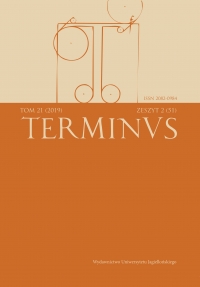Cechy gatunkowe romansu
Genre Characteristics of Romance
Author(s): Krystyna Wierzbicka-TrwogaSubject(s): Studies of Literature, Modern Age, Recent History (1900 till today), Theory of Literature
Published by: Wydawnictwo Uniwersytetu Jagiellońskiego
Keywords: romance; novel; genre; genre variant;
Summary/Abstract: The study attempts to define the genre features of romance based on the currently available research findings, but also taking into account a broader perspective of different meanings which the term assumes both in Polish and in the main European languages. Wierzbicka refers to English studies, as well as to Polish studies because these two languages have developed a similar distinction between romance and novel. The basic assumption adopted in this paper concerns the equivocal use of this term in literary studies, which obscures the picture of the history of literature. Therefore, the history of the term is discussed, which has made it possible to distinguish six different meanings of the term. The first, oldest meaning is specific to the era in which it appeared (like many mediaeval terms), and concerns works written in Romanesque vernacular languages as opposed to mediaeval Latin. It is not a name of a genre. The second meaning has been distinguished in two variants. Generally, it refers to a literary genre that is characterised by an adventurous love story and a protagonist who on principle is a lover. Variants of romance include different textual forms: in the 16th century, it was a poem of a specific narrative structure different from the epic, and in the 17th century it was (mostly) prose. The third meaning begins to dominate in the 18th century, and is an extension of the second meaning of the word “romance” in its second variant, namely, it covers all fictional prose of varied literary value. The fourth meaning was distinguished by English and Polish literary scholars of the second half of the 20th century, who undertook the 18th-century practice of juxtaposing “romance” and “novel”. They recognised “romance” as a heterogeneous epic form characterised by the extraordinary and fairy- tale character of narrative fiction. The fifth meaning of the word “romance” refers to a lyrical genre. The sixth, contemporary meaning refers to popular literature, and specifically to a narrative genre that tells a love story. Each of these six meanings illuminates a different fragment of the literary reality. In this context, the question of which of them would be the most functional in literary research becomes all the more important. Wierzbicka argues that the second meaning, similar to the sixth meaning, will allow this term to be used with reference to all literature, without the risk of ambiguity. This is because the basic generic determinant of the second meaning coincides with the contemporary reading consciousness and today’s use of the word, and thus it has a practical dimension. The following were considered genre features of romance: love story, which can optionally abound in adventures; a specific construction of the hero or heroine as one in love; the narrative structure consisting of many actions concentrated around parallel characters; prosaic or verse form; entertainment function (formerly also didactic). Historical variants of the genre are also presented, including the mediaeval chivalric romance, comic-ironic romance, 17th-century romance, sentimental romance, realistic romance. The proposed definition also enables a new look at the historicoliterary reality, especially of the mediaeval and early-modern period, whose narrative works escape the existing nomenclature.
Journal: TERMINUS
- Issue Year: 21/2019
- Issue No: 2 (51)
- Page Range: 197-214
- Page Count: 18
- Language: Polish

